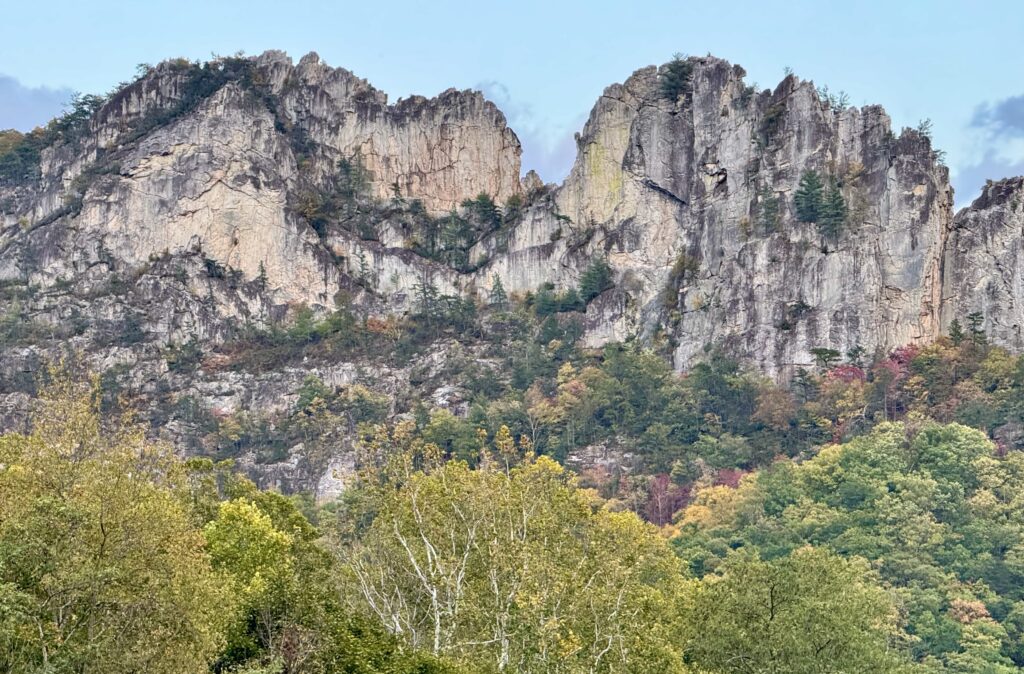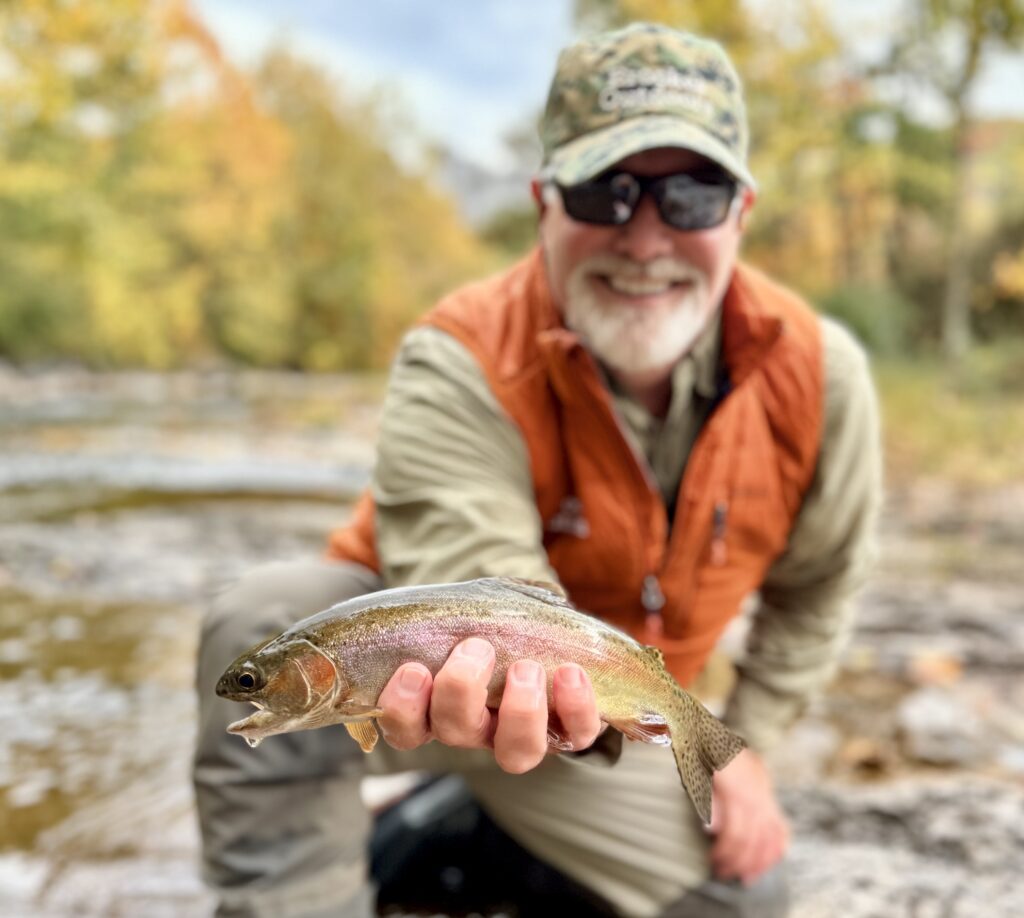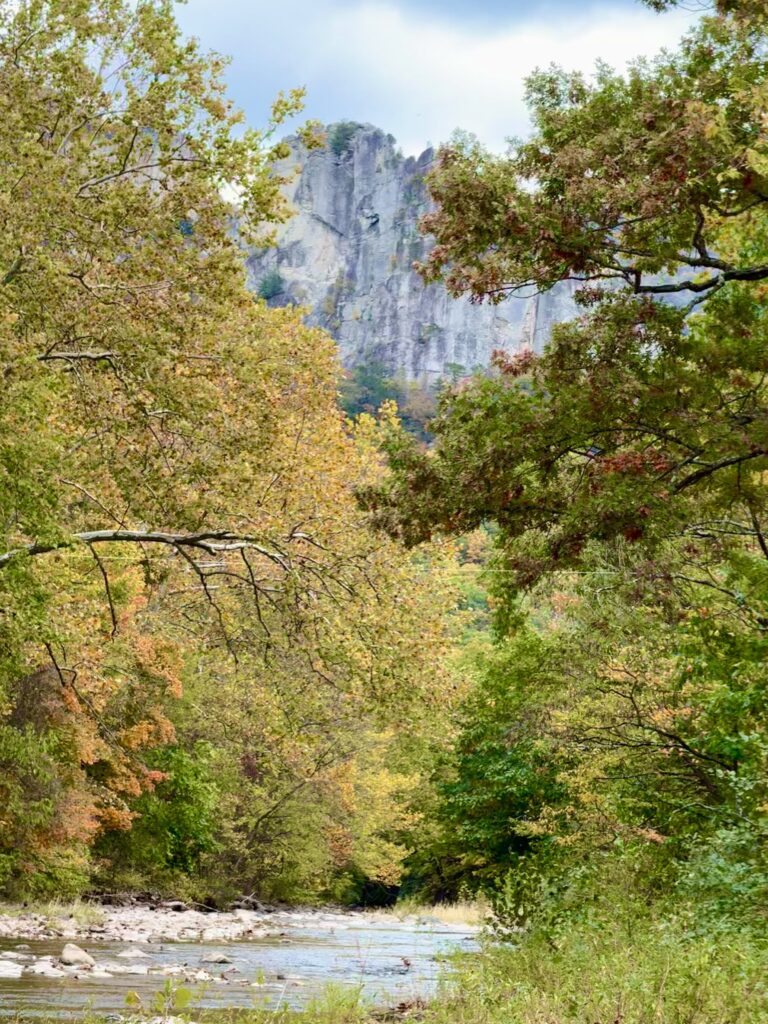Fly Fishing Seneca Creek, WV

(Note: This article by Dr. Peter Brookes first appeared in the Winter 2024 Issue of Dark Skies Fly Fishing Magazine, which you can read and download for free.)
I did some fly fishing in West By God Virginia this past summer, and I honestly couldn’t wait to get back to its wild, wonderful trout. In June, I netted an “Elk River Slam,” catching wild brook, rainbow, and brown trout on the “Lady” (as the Elk River is known locally) near Slaty Fork.
The mission of October’s return trip to West Virginia was to fish Seneca Creek near the majestic Seneca Rocks for wild rainbows and brookies. Once again, the Mountain State’s terrific trout waters didn’t disappoint.
While the well-known book, Trout Unlimited’s Guide to America’s 100 Best Trout Streams, is unfortunately a bit dated now (it was last updated in 2013), it included Seneca Creek as a top fishing destination in its last edition.
With its prevalent mountains and trout-filled streams, I can understand why some call the area the “Rockies of the East.”
On this quick, two-day trip to West Virginia, I was able to fit in an afternoon and then a morning(on separate days) of fly fishing on the Seneca with Caleb Hamner, a local guide from Elk River Inn & Cabin’s guide service I use often when I’m visiting the state to angle.

Seneca Creek's Fabulous Fishing
Reason 1 to fish Seneca Creek: The fishing is fabulous.
I easily caught 20 wild brook trout and wild rainbow trout on the Seneca over two half-days. (Wild brown trout are also reportedly in the area, but it seems to be a highly guarded secret.
An “average” day of good effort on the Seneca is netting 15 to 16 wild trout, with some fish being on the smaller side (four to six inches), according to David Thorne, West Virginia Department of Natural Resources’ Fisheries Biologist.
He quickly added that: A ‘good day’ would easily double that number of catches with good conditions, a decent hatch, and a good presentation of a worthy fly. And a good day would have more of the seven-plus inch fish rather than the smaller ones.…
David considers a nice Seneca Creek rainbow to be 9- to 11-inches with a trophy bow running in the 14- to 16-inch range; a 20-plus inch bow is occasionally reported, but David believes those mythical creatures, if they exist, are far and few between.
For brookies, an eight- to 10-incher is a solid fish with a 12- to 13-inch fish being in the trophy range for this Appalachian native of the char family. (The beloved brookie is actually from the char, and not of the trout, family.)

On the two sections of the Seneca we fished those two days, Caleb expected to find about a 50-50 split between brookies and bows, but it turned out t0 be heavy on bows, making up about 80-percent of our catch
A cold front was coming through the area, and it may have affected the hookups as a good number of incredibly fishy spots seemed surprisingly free of trout despite some (surprisingly!) respectable casts and drifts.
Nothing wrong with a few spots having no one home, especially when a couple of the bows that came to the net off the freestone creek were in the 12- to 14-inch range. (I lost one rainbow that was probably 16-inches…sigh.)
The smallish width of the creek sections I fished those two days allowed for relatively easy casts into pocket waters (a brookie favorite) and drifts in deeper, faster runs (a bow fave) with a 9-foot, four-weight rod.
(A five-weight would give more stick to bigger fish and a three-weight would certainly be more sporty…)
While not necessary, a 10-foot fly rod may help with getting across close-up currents and high-sticking, but it could be a little long in places with tight bushes and overhanging trees. Come to think of it, a long, telescoping, adjustable tenkara rod would be fun.
While records are inexact, rainbows reportedly were first introduced into West Virginia by the U.S. government in the early 1900s when the fish were moved from West Coast federal hatcheries across the country by train, likely in milk cans.
Milk cans?! I guess business class seats weren’t available…
Anyway, while the wild bows in Seneca are widely rumored to be descendent of the McCloud Redband Rainbow strain (of Northern California), it’s more likely that these original stockers were a mix of redbands, coastal rainbows, and hybrids, according to David.
He told me that based on his research: “It’s likely that the West Coast federal hatcheries weren’t overly concerned in those days with keeping strains genetically pure and, instead, were more interested in producing fish for the purpose of stocking streams.”
That assertion makes total sense to me.
Indeed, some of the rainbows had coloring similar to the beautiful redbands I previously encountered while fishing the salmon fly hatch on Oregon’s Deschutes River, so it’s likely that far-off redband genes still run through Seneca Creek trout.
DNR’s rainbow stockings in Seneca Creek reportedly ended in the early 1960, evidence that the fish are naturally reproducing well in this spring-fed stream. Equally exciting, the water is limestone-influenced, creating an aquatic insect-friendly environment.
While there were no major hatches while I was there in October, mayfly and caddis hatches are reportedly prolific, according to David, tracking closely to the schedule of most Central Atlantic bug hatches.
Thankfully, it was early enough in the fall that we didn’t have to endure the dreaded “leaf hatch.”
The dry-dropper rig on 5x tippet is a classic for the Seneca and very effective; skating a rust-colored October caddis dry fly across the water in pools, especially around structure (e.g., log jams and large rocks), drew some electric strikes from both bows and brookies.
The fishing wasn’t terribly technical (in my estimation) the days I fished it, but like the Elk River, Seneca Creek can reportedly be fickle, especially for the newer, less experienced fly angler, according to Caleb.
Thankfully, Seneca Creek’s flows were good, a welcome situation with all the drought this year in many parts of the East. A shot of precipitation would certainly make the fish happy, but there was plenty of water for good angling when I was there.
David tells me that public fishing access is good on the Seneca. The two sections we fished had plenty of parking and there’s a catch-and-release section within walking distance of the Seneca Rocks crossroads.
Do bring a wading stick and boots with some bite (e.g., cleats or felt) as I found moving in and across the creek pretty darn slippery at times. The stream might benefit from a good push of water to clean off some of the “rock snot.”

Seneca Creek's Beautiful Scenery
Reason 2 to fish Seneca Creek: The area is awesome.
Seneca Creek lies within the Monongahela National Forest and the Spruce Knob-Seneca Rocks National Recreation Area. The region is famous for the towering Seneca Rocks and hiking and rock climbing opportunities
From some old, yellowed photographs framed on the wall of a local eatery, it looks like American GIs took mountaineering training on those rocks during World War II before heading overseas.
I’ll stick to fly fishing, thank you very much.
When I left my home in Northern Virginia, the leaves were just starting to change, but when I arrived at Seneca Rocks, the foliage was in full splendor, full of gold, orange, red, and brown leaves just waiting to take flight.
The play of color of the fiery leaves on the water was fabulous.
The ride to Seneca Rocks through West Virginia’s mountains was pastoral and, regardless of the season, jaw-droppingly scenic. Take a grip-and-grin of a just-caught wild West Virginia trout with the iconic Seneca Rocks in the background.
A great way to go from “zero to hero” on social media!
My sense is that Seneca Creek isn’t heavily pressured. In fact, I didn’t see another fisher during my visit over the Columbus Day holiday weekend. That was surprising and very much welcomed, but may have just been my good fortune.
So grab your gear and hook up with some wild, wonderful West Virginia brook and rainbow trout in the clear waters of Seneca Creek before the cold comes and the snow flies. In my mind, for fly fishing, West Virginia is Almost Heaven.
______________________
Dr. Peter Brookes is an award-winning outdoor writer from Virginia. He’s going back to find those rumored wild brown trout near Seneca Rocks in the spring–if he can get someone to spill the beans. BrookesOutdoors@aol.com
Did You Enjoy This Article?
Stay up to date with the Dark Skies Fly Fishing monthly newsletter for free and receive the latest posts in fly fishing news, tricks, tips, and techniques, stream reports, as well as updates on new flies added to the Online Store and exclusive discounts!
Sign Up NowHave a fly fishing question you’d like answered? Drop us a line at info@darkskskiesflyfishing.com! If we use your question in a blog post or in the newsletter, we’ll send you a FREE fly box with a dozen of our favorite nymphs and dry flies!


“ My sense is that Seneca Creek isn’t heavily pressured. In fact, I didn’t see another fisher during my visit over the Columbus Day holiday weekend.”
Let me go write an article about it…